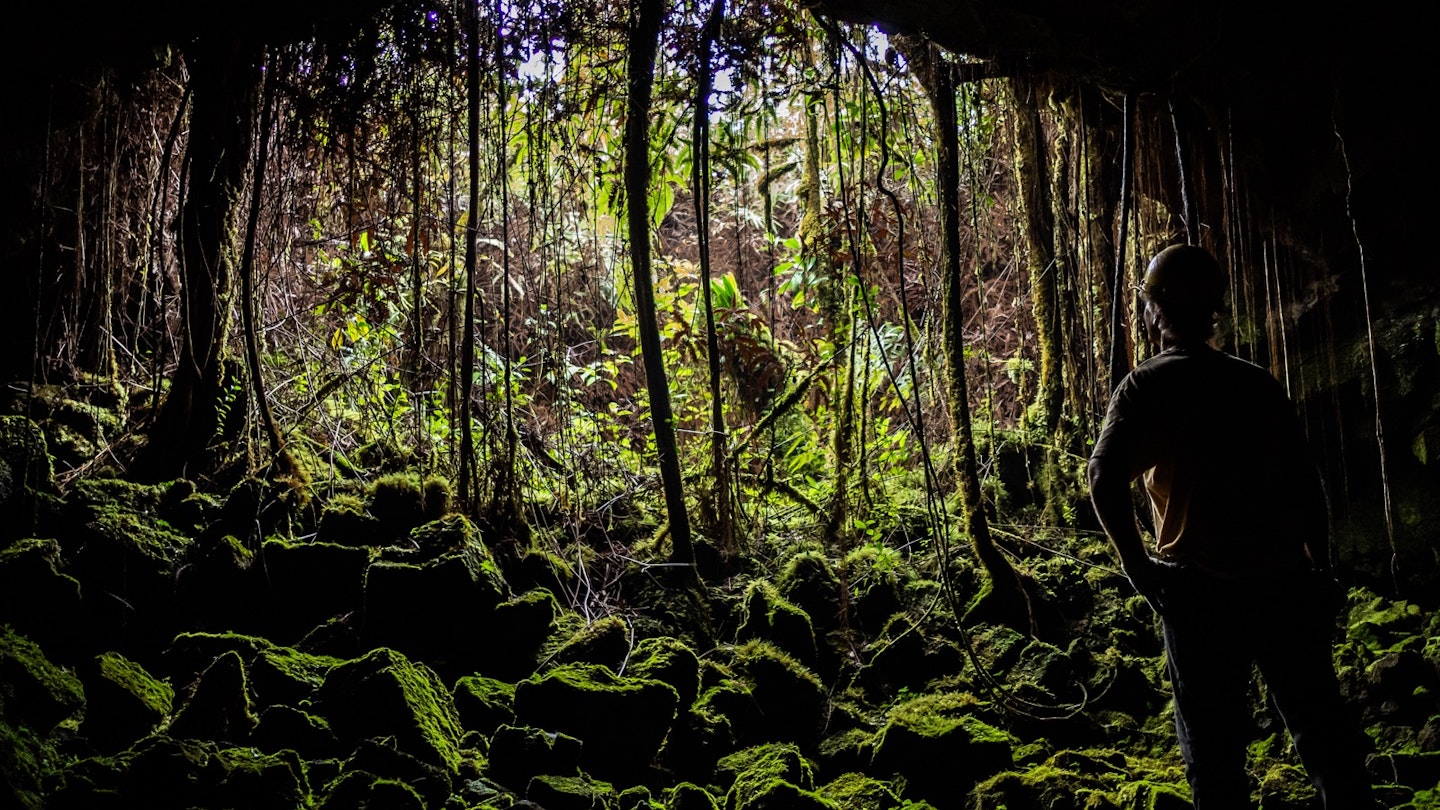Kazumura Cave: The Longest Lava Tube in the World
Recently discovered and still largely unknown, Kazumura Cave on the Big Island of Hawai’i isn’t just the longest lava tube in the world – it’s also a unique national treasure of both geological and cultural significance.
In 1994, Kazumura Cave was reported to be 29 miles long. A year later, it was recorded as 11 miles longer. Yet astonishingly, this lava tube on the Big Island of Hawai’i hasn’t changed in size for centuries. This scenario highlights the intricate nature of mapping the longest lava tube in the world. Initial mapping attempts decades ago confirmed its extraordinary length, as no other lava tube came close; however, the full extent was elusive.
It wasn’t until 1995 that adventurers uncovered connections to four previously independent lava tubes, enabling the complete mapping of Kazumura Cave — a remarkable 40-mile-long corridor of basalt. Despite being relatively shallow, with most sections rarely exceeding 16 yards below the surface, the lava tube remains relatively unknown. Local residents, many of whom own land above the tube, are often unaware that it stretches all the way from Kīlauea’s east rift zone to the coast in lower Puna.
Forged in Fire
Kazumura Cave was created during the Aila’au eruption, estimated to have occurred between 1410 and 1470, though some oral Hawaiian traditions date the event two centuries later, to the 1600s. In geological terms, both dates signify a recent point in history. Lava tubes naturally form when the top layer of a lava flow cools due to exposure to air, creating a protective crust and insulating the hotter lava below. When the magma chamber depletes, it leaves behind a hollow tube as the remnants of the lava flow.
According to native Hawaiian folklore, Kazumura Cave was formed by the goddess of volcanoes, Pele, embodying both creation and destruction. Hence, this incredible lava tube is mythologically considered woman-made. As Steve Krucker, a guide with Kilauea Caverns of Fire, eloquently states, it’s this aspect that elevates Kazumura Cave and other lava tubes to an artistic realm: ‘Unlike ordinary caves, which form over centuries through erosion, lava tubes are created in a singular event — akin to a piece of art.’
A Subway to Hell
Lava tubes contribute significantly to the expansive nature of the Big Island. Within these tubes, temperature loss is minimal, allowing pāhoehoe (smooth, ropey) lava to flow effortlessly across long distances. These natural pathways ultimately guide lava to the ocean, where new land is created. Without lava tubes, the shield volcanoes of Hawaiʻi would feature steeper inclines and the island itself would be considerably smaller.
The Big Island’s geological composition also plays a vital role in its sheer size. With magma temperatures reaching up to 2,165°F, the magma here ranks among the hottest on our planet. Situated on a geological hot spot, measuring approximately 50 miles in diameter, the magma’s intensity, combined with its unique chemical makeup and gas content, results in highly fluid pāhoehoe lava that flows for miles before solidifying into basalt.
Moreover, Kazumura Cave isn’t just notable for its length; certain sections stretch up to 23 yards wide and 20 yards high. The canyon-like structures and smooth, undulating walls lend parts of Kazumura Cave a near otherworldly aspect. Venture upslope far enough, and one might even find themselves within a magma chamber.
Subterranean Education
A journey through Kazumura Cave offers unique insights into volcanology. Entering through one of the 101 access points leads visitors into what geologists term a master lava tube. Here, nearly every lava tube feature conceivable can be observed. As lava drained, the lingering molten rock dripped and peeled, forming distinctive lava formations. Among these are unique specimens such as lavacicles and dripple spires, tubular stalactites of basalt resembling teeth.
The walls are adorned with an array of colors, resulting from elements ejected from the Earth’s core — think white gypsum, silvery magnesioferrite, and vibrant green olivine. Other remarkable volcanic remnants inside the cave include ancient lava falls, a solidified lava pond, and cupolas, the remnants of collapsed roofs.
Tread Kazumura Cave with Care
Lava tubes are among Hawai’i’s most precious, yet vulnerable, natural wonders. The delicate ecosystems supported within these caverns are under constant threat. The roots hanging from the ceilings form the backbone of a sensitive underground habitat that includes spiders, crickets, and millipedes, some species uniquely adapted to thrive in this dark environment. One such species, Schrankia howarthi, was discovered here in the 1970s by pioneering Hawaiian biospeleologist Francis Howarth. Therefore, a single misstep by unaware visitors can result in irreversible damage to these delicate ecosystems.
Culturally, lava tubes represent a significant part of Hawaiian heritage. For centuries, native Hawaiians have utilized these natural structures for burial, transforming them into sacred resting places. Within Hawaiian culture, lava tubes are considered kapu, sacred areas that should remain undisturbed. It is believed that the mana or life essence of individuals lingers within their bones long after death. Unfortunately, the theft of artifacts and the desecration of these lava tubes remains a serious issue.
Consequently, to truly appreciate Kazumura Cave and its historical significance, it is essential to visit with a guide as part of an organized tour. Thus, if you seek a profound natural wonder that has shaped both the land and its people, this cave represents an unmissable opportunity.
Make it happen: Kilauea Caverns of Fire offers three different experiences: A $29 (per person) one-hour walking tour, an $89 three-hour adventure tour, and a $279 ‘day in the cave’ by reservation.





